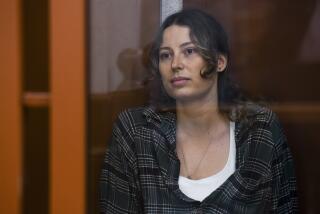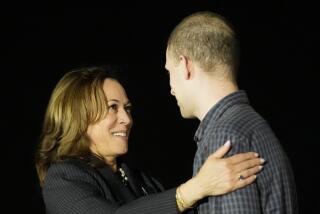Moscow Identifies 39 U.S. Civilians Seized by Stalin
MOSCOW â In 1948, New York-born Stefan Dovgulevich, 20, went to the U.S. Embassy here, declared his allegiance to America and received a U.S. passport. But when he applied to Soviet authorities for permission to leave, his U.S. passport was replaced with a Soviet one, and he was thrown into a Stalinist labor camp.
Dovgulevichâs name was one of 39 on a list published Friday of Americans who were caught in Soviet territory during or after World War II and were imprisoned in Soviet labor camps.
âThe pattern is the same in each case,â said Col. Gen. Dmitri Volkogonov, a top military adviser to Russian President Boris N. Yeltsin, who told Dovgulevichâs story to a small group of journalists.
Volkogonov is the Russian chairman of a joint Russian-American commission investigating the fates of American POWs from World War II, the Korean War and the Vietnam War who may have been held in Soviet prison camps. During a search in top-secret KGB archives for information about American POWs, the list of 39 missing American civilians was found.
It was the first information the commission has uncovered about civilians who were imprisoned by dictator Josef Stalin, and it was the most promising lead yet about missing Americans who may still be alive in the territory of the former Soviet Union, according to Bill Saxe, an official of the U.S. Defense Intelligence Agency who is working full time with the joint commission in Moscow.
The American side of the commission was informed about the findings after Volkogonov disclosed them in an interview published Thursday in the newspaper Izvestia, so the Americans have had no time to look into the fates of the 39.
âMany of these people may have died, and some of them may have returned to America,â Volkogonov said. âMaybe they had another fate.â
One of those who had another fate is Lenneta Kesselman, who is alive and well in Brooklyn, Newsday reported. Kesselman, New York-born, was taken to the Soviet Union by her mother in 1930 when she was an infant.
Last year, at the invitation of a cousin, Kesselman was allowed to return to the United States as a tourist. She indicated that she does not plan to return to Russia.
The Associated Press reported a telephone call Friday from a brother of another one of the people on the list, Irina Berko, who was of Ukrainian descent and was born in 1925. He said his sister is alive and in a convalescent home in Glassport, Pa. The brother, John Berko, said that when he and Irina were young his family had returned to its ancestral home, which was then in Poland but became part of the Soviet Union during the war. He said he fled Poland in 1939 before the Germans invaded, but his father and sister were left behind.
His sister suffered a nervous breakdown after the war and was treated in a mental hospital in the Soviet Union, Berko said, adding that he did not know if she was ever imprisoned.
Volkogonov said there is reason to believe that some of the 39 are still alive and living in the territory of the former Soviet Union, because most of them were young when imprisoned, and there is no indication that any of them died in labor camps.
âWe have a basis to believe we can find some of these people,â he said. âI think within a week or two we will receive information about the fate of one or two of them. You just need to have a bit of patience.â
Agents of the Russian Interior Ministry and Security Ministry, successor to the KGB security and espionage agency of the former Soviet Union, have been given orders to track down the people on the list. Russian officials have also asked the governments of Belarus and Ukraine, which were part of the Soviet Union but now are independent countries, to help in the search.
The last names and the locations of the individuals when they were arrested indicate that the majority of the 39 had roots in western Ukraine, which was part of Poland until World War II.
Some of the other people on the list, however, were arrested in territory that is now Belarus, others in Moscow and still others in the Baltics. It was not clear exactly why these Americans were living in these areas during wartime.
Volkogonov also told the story of Francisco Fernandez de la Vega, who was born in America in 1915.
âHe was an American citizen who tried to return (to America), but the security agency found him guilty of espionage,â Volkogonov said. âBesides that, Fernandez was accused of voicing a desire to illegally escape across the border in 1947 and of attending anti-Soviet meetings at the Argentine Embassy,â Volkogonov said.
âBecause signs that he was mentally ill were found during the investigation, a special assembly of the Security Ministry decided to put him into a mental asylum in 1948. He was subjected to forced treatment and isolation,â the general said, adding, âYou can see how tragic this is.â
Volkogonovâs candor in revealing the Americansâ stories reflects a mandate by Yeltsin for his government to come clean on the crimes against humanity committed by previous regimes.
The Russian president wants to make clear to the world that he does not condone the heinous acts of previous Kremlin leaders and that his government will not use such tactics.
âThese are bitter, sad facts that we speak about with regret--but such was the totalitarian reality,â Volkogonov said. âThe president has more than once told the Russian part of the commission that not one fact, not even the most bitter to us, can be kept hidden--because this is a measure of our humane principles and our moral convictions.â
The process of trying to track down information in the old Soviet archives about American POWs who served in Soviet labor camps has proved to be a time-consuming and difficult task. Success is slow in coming.
Many of the archives, like the one where the list of 39 civilians was found, are still off-limits to the commissionâs researchers. The commission must wait for staff members of the Security Ministry to locate such clues in archives holding tens of millions of documents.
âAlso, many documents have simply been destroyed,â Volkogonov said.
But the question remains: Why in these times of freedom in Russia have the missing Americans failed to come forward themselves?
Some may be living in remote areas, unaware of the changes. Others may be afraid to come forward because of paranoia born of decades of suffering in harsh labor camps. Still others, Volkogonov said, may have personal reasons for keeping their stories secret.
âIf someone has lived here for decades and has deep roots, he may not want to stir up (the past),â Volkogonov said.
In Washington, officials at the Pentagon and State Department were looking into the list Friday.
âWe only just got it. . . . The first step is to find out who these people are and then try to find their family members,â said Air Force Capt. Susan Strednansky, a Pentagon spokeswoman.
Times staff writer Michael Ross in Washington and Sergei Loiko, a researcher in The Timesâ Moscow Bureau, contributed to this article.
American Captives Named
Here is a list of 39 people a top Yeltsin adviser says are Americans imprisoned in the Soviet Union during and after World War II who may still be alive. The adviser, Col. Gen. Dmitri A. Volkogonov, said all had U.S. passports or were born in the United States. The list, dated 1954, was translated from Russian to English by The Times. Two of those people named on the list were located in the United States on Friday:
* Sagatas, Adel Alexandrovna, born 1906, town of Rokishkis, Lithuania.
* Berko, Irina (Irene) Mikhailovna, born 1925 in Braddock, Pa., U.S.A., Ukrainian, lived in the village of Rodatychi, Gorodoksky district, Lvov region.
* Dovgulevich, Stepan (Stefan) Stepanovich, born 1927 in New York, Belarussian, lived in Donetsk region.
* Fedak, Maria Petrovna, born 1903 in the U.S.A., (ethnically) Hungarian, and her children, lived in Transcarpathian region.
* Dragula, Anna Dmitrievna, Transcarpathian region, and her children -- Vasily (Charlie) Fyodorovich, born 1923; Fyodor (Frank) Fyodorovich, born 1930; Maria (Mary) Fyodorovna, born 1925; Margarita (Margaret) Fyodorovna, born 1929; Ivan (John) Fyodorovich, born 1928. (They all) lived in the town of Mukhachevo, Transcarpathian region.
* Severinchik, Pavel (Paul) Kirillovich, born 1917 in Chicago, lived in the Brest region.
* Koretskaya (Kolodiy), Maria Vasilievna, born 1919 in New York, lived in the village of Slovita, Glinyansky district, Lvov region.
* Rudyk, Luetta (Lietta), born 1890, Passaic, U.S.A., lived in the Lvov region.
* Nikitchik, Daniil (Daniel) Danilovich, born 1936, and his brother Nikitchik, Fyodor, born 1927, both in Chicago.
* Semko, Mikhail (Michael) Ivanovich and his brother Semko, Ivan (Ian) Ivanovich, born 1922 in Omrod, U.S.A., lived in the village of Petrichi, Krasnoyarsky district, Lvov region.
* Ignatyuk, Alexander Andreyevich, born 1910 in New York, Belarussian, lived in Brest region.
* Kesselman, Lenneta (Linnet) Iosifovna, born 1930, New York, lived in the city of Barnaul, and her brother Kisselman, Bernard, lived in the city of Gorky (now Nizhny Novgorod).
* Korishchin (Karizhin), Bogdan Ivanovich, born 1921 in New York, lived in the town of Grimailov, Ternopol region.
* Gitska, Ivan Vasilievich, born 1917, and his brother Gitska, Mikhail Vasilievich, born 1920, Wilmington, U.S.A., lived in Dragobych region.
* Krivenko, Yuri (Georgy) Mikhailovich, born 1924 in the U.S.A., lived in the town of Beregovo, Transcarpathian region.
* Megits, Vasily (Basil), born 1916, and his brothers Stepan (Stefan) Dmitrievich, born 1918, Fyodor Dmitrievich, born 1920, both of New York, lived in the village of Tarnava, Dobromilsky district, Dragobych region.
* Kazun, Valentina Vasilievna, born 1933, and Kazun, Vladimir Vasilievich, born 1935 in the village of Shepets, Ostrinsky rural soviet, Vasilizhkovsky district, Grodno region.
* Blyakh, Grigory Pavlovich, born 1932 in the village of Strievka, Zbarazhsky district, Ternopol region.
* Tseslyak, Mechislav Vatslavovich, born 1910 in U.S.A., lived in the Grodno region.
* Kazanskaya, Sofia Vikentievna, born 1913 in Detroit, U.S.A., lived in the city of Stryy, Lvov region.
* Marshall, Iozas (Josef), son of Kazis, born 1897 in Utica, U.S.A., his wife Marshall, Paulina, daughter of Antanas, born 1903, and daughter Marshall, Aldona, born 1926, lived in the city of Kaunas (Lithuania).
* Fernandez de la Vega, Francisco Manuelovich, (ethnically) Spanish, born 1915 in the U.S.A., lived in Moscow.
* Yarema (Jarema) John Andreyevich, born 1918 in Irgas, U.S.A., lived in the village of Pyatnitsa, Dobromilsky district, Dragobych region.
* Yasinskas Francis (Pranas), born 1910 in Brooklyn, U.S.A., lived in Prensky district, Lithuania.
* Muller, Ida, born 1893, (ethnic) German.
More to Read
Sign up for Essential California
The most important California stories and recommendations in your inbox every morning.
You may occasionally receive promotional content from the Los Angeles Times.










